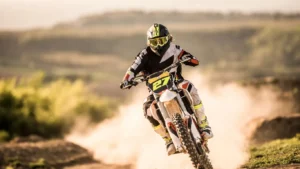In the exciting realm of extreme sports and daredevil feats, car jumping stunts hold a distinctive allure. These gravity-defying performances offer a thrilling spectacle of physics, precision, and raw nerve, captivating audiences worldwide.
The adrenaline-fueled excitement of launching a vehicle into the air, the suspense during the flight, and the relief of a successful landing, make car jumping stunts irresistible to thrill-seekers. However, these stunts also involve significant risks, requiring comprehensive preparation and expert execution to ensure safety.
Understanding the Basics
Physics Behind Car Jumping Stunts
Car jumping requires understanding gravity, momentum, and energy conservation. The car’s trajectory and landing depend on its speed, weight, ramp angle, and length.
Essential Car Jumping Equipment
Safety equipment, including roll cages, seat belts, and fire suppression systems, are vital. Helmets, fire-resistant suits, and neck braces can protect the stunt driver from potential injuries during the jump.
Choosing the Right Vehicle for Jumps
Not every car can handle the stress of a jump. The ideal stunt vehicle should have a strong frame, a powerful engine, and a suspension system capable of absorbing the impact of landing.
Preparing for the Car Jump
Car jumping stunts require meticulous preparation to ensure safety and success. The process involves careful planning, vehicle modifications, rigorous training, and safety measures. Here’s a detailed look at the steps involved in preparing for a car stunt:
1. Planning the Stunt
The first step is to plan the stunt in detail. This involves deciding the type of jump, calculating the required speed and ramp angle, and determining the landing area.
This involves deciding the type of jump, calculating the required speed and ramp angle, and determining the landing area.
2. Choosing the Right Vehicle
The choice of vehicle is crucial for a successful car jump. The ideal car is lightweight yet sturdy, with a powerful engine and a reliable suspension system. The car’s weight distribution should be balanced to ensure stability during the jump.
3. Modifying the Vehicle
The car used for the stunt often requires modifications to enhance its performance and safety. This could include reinforcing the car’s structure, upgrading the suspension and braking systems, and installing a roll cage. A professional mechanic with experience in stunt vehicles should perform these modifications.
4. Training the Driver
The driver must be thoroughly trained in the specific skills required for car jumping. This includes understanding the mechanics of the jump, maintaining control during the approach, lift-off, flight, and landing, and emergency procedures in case something goes wrong.
5. Setting Up the Ramp
The ramp used for the jump must be carefully designed and built. It should be strong enough to support the car’s weight, and the angle must be precisely calculated to achieve the desired trajectory. The ramp should also have a smooth surface to ensure a clean lift-off.
6. Safety Preparations
Safety is paramount in car stunts. The driver should be equipped with protective gear such as helmets, fire-resistant suits, and neck braces. The car should be fitted with safety equipment like seat belts and fire suppression systems. A medical team should be on standby during the stunt, and the area should be cleared of unnecessary personnel and equipment.
7. Rehearsals
Before the actual stunt, it’s essential to conduct rehearsals to test the car, ramp, and driver. This allows any potential issues to be identified and resolved, and it helps the driver to become familiar with the specifics of the jump.
In conclusion, preparing for a car stunt involves a lot of work behind the scenes. Every detail is crucial to ensure that the stunt is both spectacular and safe.
I have also prepared an article on jumping dirt bikes, and if you read that post, you will be able to learn how to jump a dirt bike.
The Mechanics of Car Jumping Stunts
Car jumping stunts, while thrilling to watch, are rooted in the fundamental principles of physics. Understanding these principles can provide valuable insights into the mechanics of car jumping stunts. Let’s dive into these mechanics:
1. The Role of Physics in Car Jumping
Two primary physical principles govern car jumping: gravity and momentum.
Gravity is the force that pulls objects towards the earth. Gravity pushes an automobile down from the ramp. The initial momentum (a product of the car’s mass and velocity) counters this force, allowing the car to travel a certain distance before gravity brings it back to the ground.
The trajectory, or the path that the car follows during the jump, is parabolic due to the influence of gravity. This is why the car rises and then falls during the jump, forming a curve.
2. The Importance of Speed and Ramp Angle
The jump depends on the car’s lift-off speed and ramp angle.
The speed provides the car with the necessary momentum to overcome gravity for a certain amount of time. Too slow, and the car won’t travel far. Too fast, and the car may become unstable or overshoot the landing area.
The ramp angle determines the direction of the car’s momentum. A steeper angle gives a higher, shorter jump, whereas a lower angle gives a longer, lower jump.
3. The Effect of Car Weight and Distribution
The car’s weight and its distribution also play a significant role in car jumping stunts.
A heavier car requires more speed to achieve the same jump as a lighter car. This is because the heavier car has more mass, and thus needs more momentum to counteract gravity.
The weight distribution affects the car’s balance during the jump. If the car is heavier at the front, it may tip forward during the jump. Similarly, if it’s heavier at the back, it may tip backward. This can make the landing dangerous if not controlled properly.
4. Controlling the Car in Mid-Air
While in mid-air, the car is essentially in free fall, with limited control options. However, skilled drivers can manipulate the car’s orientation slightly by using the throttle and brakes, a technique known as ‘throttle steering’.
Accelerating tends to lift the car’s front due to the gyroscopic effect, while braking tends to lower it. This can help the driver adjust the car’s pitch to prepare for a smooth landing.
5. The Impact of Landing
The jump’s landing puts the automobile and driver under the highest stress. The car’s suspension absorbs the impact and protects its structure.
In conclusion, the mechanics of car jumping stunts involve a complex interplay of physical principles, vehicle characteristics, and driver skill. Understanding these mechanics can help in planning and executing safer and more spectacular stunts.
Executing the Car Jump
Executing a car jump stunt involves a sequence of precise actions, each playing a crucial role in the stunt’s success. From the approach to lift-off, flight, and landing, each phase demands expert skill and precision.
Approach and Lift-Off
The approach is the first step in the execution of the car jump. It involves driving the vehicle towards the ramp at the calculated speed. This speed is vital to ensure that the car gains enough momentum to complete the jump. Too slow, and the car might not reach the desired height or distance. Too fast, and the car might overshoot the landing area or lose control.
As the car ascends the ramp, the driver must maintain control and steady speed. A slight misjudgment can alter the car’s trajectory or cause instability. The lift-off should be smooth, with the car leaving the ramp evenly and not tilting to one side.
Mid-Air Control
Once airborne, the car’s movement is largely governed by physics, primarily gravity and momentum. However, skilled drivers can manipulate the vehicle’s orientation slightly while in the air. “Throttle steering” adjusts the car’s pitch using the throttle and brakes. Accelerating raises the car’s front, while braking lowers it. This control is essential for ensuring a smooth landing.
Landing and Post-Jump
The landing is perhaps the most critical part of the car jump. A successful landing requires the car to touch down on all wheels simultaneously. If the car lands nose-first, it can result in a dangerous crash. Landing on the rear wheels can cause the car to bounce and lose control.
The ideal landing spot is a downward slope that matches the car’s angle of descent. This reduces the impact on the car and the driver, making the landing smoother and safer.
After landing, the driver must swiftly regain control to stop safely. This requires careful handling, as the car may behave unpredictably after the impact of landing.
Safety Measures
In all phases of the jump, safety should be the top priority. The driver should be equipped with protective gear such as helmets, fire-resistant suits, and neck braces. Roll cages, seat belts, and fire suppression systems should be installed. Always have emergency medical personnel on hand.
Executing a car jump requires a combination of meticulous planning, expert driving skills, and strict safety measures. Despite the risks involved, the thrill and spectacle of a successful car jump make it a popular and exciting stunt performance.
Advanced Car Jumping Techniques
Advanced car jumping techniques take the art of car stunts to a whole new level, incorporating complex maneuvers that demand additional skills and precision. These techniques are generally undertaken by experienced professionals who have mastered the basics of car jumping and are ready to push their skills even further. Let’s explore some of these advanced car jumping techniques:
1. Barrel Rolls
A barrel roll is a stunt where the car flips over in mid-air along its longitudinal axis, forming a roll similar to a barrel. This is an incredibly challenging stunt that requires precise speed, ramp angle, and mid-air control. The car must be perfectly balanced upon lift-off to successfully perform a barrel roll without losing control.
2. Spins
A spin involves rotating the car around its vertical axis while in mid-air. This requires the driver to initiate the spin during the approach or lift-off, then control the rotation speed to ensure the car faces the correct direction for landing.
3. Corkscrews
The corkscrew is one of the most difficult car jumping techniques. It involves flipping the car end-over-end while also spinning it sideways, much like a corkscrew. This requires a specially designed ramp and precise control over the car’s speed and trajectory.
4. Jumps with Multiple Vehicles
Jumps involving multiple vehicles require a high level of coordination and timing. Each vehicle must be precisely synchronized to avoid collisions. This type of stunt can create an impressive spectacle, such as two cars jumping side by side or one car jumping over another.
5. Parachute-Assisted Jumps
In parachute-assisted jumps, the car is fitted with a parachute that deploys during the jump. This can slow the car’s descent, allow for longer jumps, and provide additional control over the landing. However, it requires careful timing to deploy the parachute correctly without disrupting the car’s balance.
6. Pyrotechnic Stunts
Pyrotechnic stunts involve the use of explosives and fire to add spectacle and drama to the car jump. This could include the car jumping through a ring of fire or triggering an explosion during the jump. To ensure safety, pyrotechnic specialists plan and coordinate these stunts.
It’s important to note that these advanced techniques come with increased risk and should only be attempted by experienced professionals under controlled conditions. Protective gear, car safety devices, and medical staff must be used. With the right preparation, advanced car jumping techniques can offer an exhilarating display of driving skill and daring.
Role of Technology in Car Stunts
Modern Advancements: CGI and its Impact on Car Jumping Stunts
With advancements in Computer-Generated Imagery (CGI), many film stunts are now created digitally. While this reduces the risk factor, it also means fewer opportunities for real-life stunt performers. However, many audiences still appreciate the authenticity and thrill of genuine car jumping stunts.
Future of Car Jumping: Drone Technology and Beyond
Emerging technologies may further revolutionize car jumping stunts. For example, drones can capture stunning aerial footage of stunts, enhancing the viewer experience. Furthermore, advancements in vehicle design and safety equipment will continue to influence the future of car jumping.
Conclusion
Car jumping stunts represent a thrilling blend of physics, skill, and courage. By understanding the science behind these stunts and respecting the associated risks, stunt performers can defy gravity and push the boundaries of what’s possible, creating spectacles that captivate and amaze audiences worldwide.
Frequently Asked Questions
Many famous car jumps have graced the silver screen, such as the Aston Martin DBS jump in “Casino Royale” and the various jumps in the “Fast and Furious” franchise. In the world of professional stunts, Travis Pastrana’s record-breaking jump in Las Vegas is legendary.
The ideal stunt car is lightweight yet robust, with a powerful engine and a durable suspension system. Cars that have been used successfully for stunts include the Mini Cooper, Subaru Impreza, and various models of muscle cars.
Vehicle jumping is dangerous. Fractures, concussions, whiplash, and internal traumas are common.. Safety precautions and protective clothing reduce these dangers.






